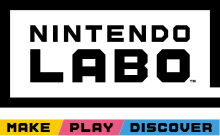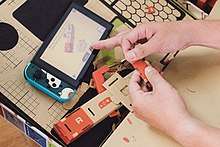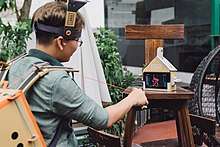Nintendo Labo
 | |
| Manufacturer(s) | Nintendo EPD |
|---|---|
| Publisher(s) | Nintendo |
| Publication date |
|
| Genre(s) | Interactive model kit |
| System(s) | Nintendo Switch |
| Material(s) required | Cardboard, craft materials |
| Media type | Toy |
| Slogan | Make, Play, Discover |
| Website | https://labo.nintendo.com/ |
Nintendo Labo (ニンテンドーラボ Nintendō Rabo) is a gaming and construction toy platform developed by Nintendo and used as an extension for the Nintendo Switch video game console, which was released in April 2018. The platform uses kits that include cardboard cut-outs and other materials that are to be assembled in combination with the Nintendo Switch console display and Joy-Con controllers to create "Toy-Con" that can interact with game software and vice versa. Nintendo designed Labo as a way to teach principles of engineering, physics, and basic programming.
Construction and gameplay

Nintendo Labo is released as individual Labo Kits, each containing a set of pre-made cardboard cut-outs and other materials, used to make one or more "Toy-Con", and a Nintendo Switch game card, which contains interactive instructions on how to assemble the Toy-Con and software that the Toy-Con can interact with. Once each Toy-Con is constructed, players insert the main Nintendo Switch display and/or one or both of the Joy-Con controllers according to the instructions. Each Toy-Con functions differently in the ways it interacts with either the Joy-Con or the main display. For example, the piano Toy-Con's keystrokes are read by the Right Joy-Con controller's infrared sensor to identify notes being played, while robotic Toy-Con move using HD Rumble from the Joy-Con controllers, which are controlled via the touchscreen. Players may freely decorate the cardboard parts using coloring pens, tape, and other materials, while more experienced users can invent new ways to play with each Toy-Con.[1][2] The game software provides instructions on how the Toy-Con works with the Switch, such as describing the fundamentals of infrared sensing.[1][3]
Toy-Con Garage
The Nintendo Labo software comes with a feature called "Toy-Con Garage", which allows users to create and program their own Toy-Con using simple programming commands, either starting with the available Labo kits, or with their own materials.[4] Toy-Con Garage is based upon creating simple commands by connecting input and output nodes. When an input is performed, it will trigger the connected output event. Additional middle nodes can be added to modify the input. For example, an input node can be a specific button press or a controller movement, while the middle node can set a required number of presses in order for the output to occur. Output nodes range from vibrating the Joy-Con to lighting up the Console's display. Toy-Con Garage provides multiple options for customizing each node, such as adjusting the sensitivity and direction of the control stick as an input node. Multiple input-output commands can be used in combination to create more complex creations.[5]
Development
Labo was announced on January 17, 2018. According to Nintendo of America president Reggie Fils-Aimé, "Labo is unlike anything we've done before", and was developed to extend the age audience for the Switch.[1] Nintendo said the product was "specifically crafted for kids and those who are kids at heart."[6] The tagline for Labo is "Make, Play, Discover"; the discovery part arises from how the user of the Toy-Con can understand the fundamentals of physics, engineering, and programming that make the Toy-Con work through the act of making and playing with them. The product was not originally intended to be educational, though one of its goals was to "explain how the technology behind the Toy-Con creations works".[7]

The concept of Labo came from Nintendo when they asked their employees to come up with ways that the Switch's Joy-Con could be used; out of many potential ideas, the idea of building cardboard toys around the controllers held promise. According to Shinya Takahashi, the use of cardboard as part of playthings is a common practice among Japanese children, and as they started prototyping ideas, they found the "trial and error" process of putting together the cardboard toys was "extremely fun".[8] As the Labo concept was developed, they found it fit well within Nintendo's overall philosophy on innovating new ways to have fun, and had potential to introduce the Switch to more than just game enthusiasts.[8]
Nintendo Labo developers Kawamoto, Sakaguchi, and Ogasawara stated in an interview that their goal was to use the unique features of the Nintendo Switch in such a way that no other system could emulate. The Joy-Con were treated as a "bundle of sensors" that could be used in a multitude of ways by attaching them to different hardware pieces, focusing on the gyro motion-sensor, IR motion camera, and HD Rumble features.[9] The team was tasked with exploring Joy-Con attachment and game prototypes during three weeks of brainstorming sessions, called "prototype parties."[10][11] When asked about the choice of building material, the developers responded by saying that cardboard was chosen over plastic because the 3D printer they were using for prototyping was unable to keep up with their pace of testing; cardboard would also allow for the player to create, repair, and customize the project themselves.[12] The initial construction designs were first thought as being simple to construct, but later proved to be complex and challenging when it was decided that no cutting or gluing would be required to assemble the kits. Improvements were made to the prototypes based on feedback from consumer and developer testing; this prompted the creation of the interactive instruction software, as well as favoring simplicity over appearance. During development testing—prior to the cardboard designs being finalized—photographs were taken and compiled into booklets to be used as temporary instruction manuals; these booklets ranged from 1,000 pages for simpler models to 3,000 pages for complex ones.[13] While the cardboard Toy-Con are sturdy, Nintendo recognized that the cardboard can suffer wear and tear with time, and sells replacement sheets for individual Toy-Con through its online store.[2][14][15] When asked about the durability of Labo during an interview with CNET, Yoshiyasu Ogasawara stated, "We tested their resilience to the same action through hundreds and thousands of repetitions, so we expect them to last a long time under normal use."[16]
Labo Kits
Two Labo Kits, Variety Kit and Robot Kit, were announced for launch in North America, Australia, and Japan on April 20, 2018, and in Europe on April 27, 2018.[17] An accessory set containing stencils, stickers, and tape are available separately.[18] Replacement packs for individual parts and Toy-Con are available for purchase on Nintendo's online store,[14][15] while free templates for the cardboard cut-outs are also available for download.[19] While Nintendo did not confirm any additional Toy-Con kits at launch, journalists observed that other Toy-Con configurations were shown in the announce trailer, suggesting that additional kits may be announced at a later date.[20][21]
Variety Kit

The Variety Kit contains kits for five individual Toy-Con:
- Two remote-controlled cars, where the vibrations from the Joy-Con serve to provide momentum and steering to the car. The game software allows the player to control the car like a normal remote-controlled vehicle using the console itself as the controller. The software also allows for the car to follow targets using the IR motion camera of the right Joy-Con.
- A fishing rod where the Joy-Con sit in the reel and the handle of the rod. The game receives motion input from the Joy-Con to simulate a fishing game.
- A toy piano with a full octave of keys; the console sits atop this to serve as a music stand.
- A motorbike with Joy-Con inserted into the handlebars on either side of the Console for steering. The Toy-Con Motorbike is also compatible as a motion controller in Mario Kart 8 Deluxe.[22]
- A house containing a slot to insert different components that can interact with the game software on the Console's display.
The kit comes with a game cartridge that contains interactive instructions of how to assemble each Toy-Con, and at least one software package to use the Toy-Con. Some Toy-Con have multiple programs; for example, the motorbike handles allow the player to race along a track in stunt bikes, and gives the player the ability to create new track layouts, or to use any object detected through the IR sensor to create a track based on that object. Similar IR sensing abilities allows the player to create new fish to catch in the fishing rod Toy-Con, or to create new waveforms to use on the piano Toy-Con.[23]
Robot Kit

The Robot Kit includes parts to make a mecha suit that includes a visor which holds the left Joy-Con for motion sensing and a backpack that holds the right Joy-Con to read hand and feet swings. This allows the player to rampage through a virtual world presented on the screen.[2] The software includes multiple game-modes: Robot, VS, Challenge, Robo-Studio, and the Hangar. Robot mode gives the player the ability to control the giant robot as it attacks targets across a cityscape, to control the robot as it flies over a city, and to transform in a tank. The two-player VS mode allows players to fight with their giant robots, though both players need a separate Robot Toy-Con for this mode.[23] In Challenge Mode, the player can complete missions to unlock special abilities that can be used in the game's other modes. The Robo-Studio mode allows the player to insert the Console into the Toy-Con and play sound effects based on the player's movement, while the Hanger allows the player to customize the color and appearance of their virtual robot.[24]
Journalists noted similarities between this Kit and Project Giant Robot, a software title for the Wii U that had players use the motion sensing of the Wii U GamePad to control a robot and rampage through a city. Project Giant Robot was teased during E3 2014 and believed to be tied to Star Fox Zero, but was ultimately cancelled by Nintendo.[25][26] Labo developers stated in an interview that the original prototype was a ground-based tank with interactive floor pedals, but risked being crushed by the user and did not utilize the potential of the Joy-Con's gyro sensor; to solve these issues, the prototype was modified to be worn as a "Carry-Con" on the user's back.[12]
Vehicle Kit
Nintendo announced its first post-release Labo Kit in July 2018, which was released worldwide on September 14, 2018. The Vehicle Kit includes the cardboard parts to make three steering consoles, one for a car, one for a plane, and one for a submarine, each with a slot for a "key" that is built around a Toy-Con. The associated game allows players to control cars, planes, and submarines in game, switching between these modes by moving their Toy-Con key between units, and supports co-operative play with a second person using another Toy-Con.[27]
Interactions with other games
A free update to Mario Kart 8 Deluxe in June 2018 allowed players to use the motorbike Toy-Con, from the Variety Kit, to control their racer in the game.[28] In August 2018, Nintendo announced that the car steering wheel Toy-Con from the upcoming Vehicle Kit will also be compatible with Mario Kart 8 Deluxe.[29] After unveiling a tech demo in April 2018,[30] Rayark Games announced their title Deemo will gain limited support for the piano Toy-Con, from the Variety Kit, in October 2018,[31] marking as the first third-party title to support Nintendo Labo.[32]
Reception
On the day after its announcement in January 2018, Nintendo's stock price jumped around 2.4%, representing about US$1.4 billion to their value. Analysis suggested that Labo was the type of unorthodox product that only Nintendo could develop and market, showing a further return to their more financially-successful period about a decade prior, leading to the rising stock price.[33]
Nintendo Labo was received with praise for its unique take on video gaming and unconventional method of play,[34][35] and its ability to encourage creativity and learning, especially in children.[36] Reviewers primarily praised the enjoyable building experience and easy to follow step-by-step instructions;[37] the rotatable camera and fast-forward/rewind features were appreciated, as well as the sense of humor that the instructions contain.[38][37] Critics were initially concerned with the sturdiness of the cardboard, but were impressed with the durability of the assembled Toy-Con,[36][39] also noting that the software contains tutorials with tips on repairing broken Toy-Con.[37][36] Reviewers were mixed on the enjoyment and limited replay value of the software's gameplay,[34][38] with Andrew Webster from The Verge saying "the games are perhaps the least interesting part of Labo."[37] However, critics highlighted the seemingly unlimited options provided by Toy-Con Garage, and the possibility for the community to develop and share new creations.[40][41] The Verge and CNET found Labo to be a clever utilization of the Joy-Con controllers' motion sensors, HD Rumble, and IR sensing abilities.[37][36]
Labo was featured in a May 2018 episode of The Tonight Show Starring Jimmy Fallon, where Jimmy Fallon, Ariana Grande, and The Roots used various kits and Switches in a performance to premiere Grande's single, "No Tears Left to Cry".[42][43][44]
Some players have found ways to recreate the cardboard Toy-Con functionality with more sturdy versions using Lego bricks, otherwise retaining all the functionality of the original toys.[45]
Sales
In Japan, Variety Kit sold 90,410 copies within the first week, placing it first on the all-format sales chart, while Robot Kit sold 28,629 copies, placing it third.[46] As of August 2018, Variety Kit has sold 222,514 units in Japan,[47] and all kits consolidated have sold 1.39 million units worldwide.[48]
References
- 1 2 3 Webster, Andrew (January 17, 2018). "Nintendo is making a bunch of weird DIY cardboard toys for the Switch and they're awesome". The Verge. Archived from the original on January 17, 2018. Retrieved January 17, 2018.
- 1 2 3 McDonald, Keza (January 17, 2018). "'Like cardboard Lego': Nintendo Labo turns homemade models into interactive toys". The Guardian. Archived from the original on January 17, 2018. Retrieved January 17, 2018.
- ↑ Hoggins, Tom (January 17, 2018). "Nintendo Labo - Hands-on with the Switch's brilliant and barmy cardboard toys". The Daily Telegraph. Archived from the original on January 17, 2018. Retrieved January 17, 2018.
- ↑ Frank, Allegra (February 1, 2018). "Nintendo Labo Toy-Con Garage lets you make your own custom playthings". Polygon. Archived from the original on February 2, 2018. Retrieved February 1, 2018.
- ↑ Crecente, Brian (March 15, 2018). "New 'Nintendo Labo' Vid Details Toy-Con Garage Programming". Glixel. Archived from the original on March 15, 2018. Retrieved March 15, 2018.
- ↑ Kuchera, Ben (January 17, 2018). "What is Nintendo teasing for the Switch? (update)". Polygon. Archived from the original on January 18, 2018.
- ↑ "Developer Interview: It's fun to "Make, Play, and Discover" - Nintendo Labo Official Site". labo.nintendo.com. Retrieved April 20, 2018.
- 1 2 Hester, Blake (February 9, 2018). "Nintendo Talks Labo Origins and Wanting "Every Single Person" To Own A Switch". Glixel. Archived from the original on February 10, 2018. Retrieved February 9, 2018.
- ↑ "Developer Interview - Nintendo Labo Official Site". labo.nintendo.com. Retrieved April 20, 2018.
- ↑ "Developer Interview Part 2 - Nintendo Labo Official Site". labo.nintendo.com. Retrieved April 20, 2018.
- ↑ "Developer Interview: A cross-team collaboration - Nintendo Labo Official Site". labo.nintendo.com. Retrieved April 20, 2018.
- 1 2 "Developer Interview: Why we decided to use cardboard - Nintendo Labo Official Site". labo.nintendo.com. Retrieved April 20, 2018.
- ↑ "Developer Interview: An eye-opening consumer test - Nintendo Labo Official Site". labo.nintendo.com. Retrieved April 20, 2018.
- 1 2 "Nintendo's online store now has replacement parts for Nintendo Labo - Nintendo Everything". Nintendo Everything. April 19, 2018. Retrieved April 20, 2018.
- 1 2 "Nintendo Labo™ for the Nintendo Switch™ home gaming system - Toy-Con Garage". labo.nintendo.com. Retrieved April 20, 2018.
- ↑ Stein, Scott (April 20, 2018). "How long will Nintendo Labo's cardboard last? Labo's creators answer our questions". CNET. Retrieved April 21, 2018.
- ↑ McWhertor, Michael (January 17, 2018). "Nintendo reveals Labo, a DIY 'build-and-play experience' for Switch". Polygon. Archived from the original on 2018-01-18. Retrieved January 17, 2018.
- ↑ Frank, Allegra (January 17, 2018). "Nintendo Labo: Everything we know". Polygon. Archived from the original on 2018-01-18. Retrieved January 17, 2018.
- ↑ Dale, Laura Kate (April 20, 2018). "Yes, You Can Download Replacement Labo Templates For Free". Kotaku UK. Retrieved April 22, 2018.
- ↑ Oxford, Nadia (January 18, 2018). "Nintendo Labo Trailer Teases Future Toy-Cons". US Gamer. Archived from the original on January 19, 2018. Retrieved January 18, 2018.
- ↑ Frank, Allegra (January 18, 2018). "Nintendo Labo reveal teased a lot of unannounced Toy-Cons". Polygon. Archived from the original on January 18, 2018. Retrieved January 18, 2018.
- ↑ Plunkett, Luke (June 25, 2018). "Mario Kart 8 Deluxe Now Supports Nintendo Labo". Kotaku. Retrieved June 26, 2018.
- 1 2 Mackovech, Sam (February 14, 2018). "The games behind the cardboard: We finally know how Nintendo Labo will play". Ars Technica. Archived from the original on February 15, 2018. Retrieved February 15, 2018.
- ↑ Grant, Christopher (February 15, 2018). "Nintendo Labo Variety Kit and Robot Kit detailed in new videos". Polygon. Retrieved April 5, 2018.
- ↑ Kohler, Chris (January 17, 2018). "That Nintendo Labo Robot Game Looks Awfully Familiar". Kotaku. Archived from the original on January 18, 2018. Retrieved January 17, 2018.
- ↑ Mackovech, Sam (January 17, 2018). "Nintendo's Labo playset slaps the Switch into build-your-own cardboard toys". Ars Technica. Archived from the original on January 17, 2018. Retrieved January 17, 2018.
- ↑ McWhertor, Michael (July 26, 2018). "New Nintendo Labo kit is all about vehicles". Polygon. Retrieved July 26, 2018.
- ↑ Bankhurst, Adam (June 25, 2018). "Nintendo Labo Now Compatible With Mario Kart 8 Deluxe". IGN. Retrieved June 25, 2018.
- ↑ Craddock, Ryan (August 24, 2018). "The Nintendo Labo Vehicle Kit Will Work With Mario Kart 8 Deluxe On Switch". Nintendo Life. Retrieved August 31, 2018.
- ↑ Craddock, Ryan (April 26, 2018). "Video: Rayark Shows Off Deemo Tech Demo With Nintendo Labo Piano Support". Nintendo Life. Retrieved August 31, 2018.
- ↑ Wong, Alistair (August 26, 2018). "Deemo To Receive Nintendo Labo Toy-Con Piano Support In October". Siliconera. Retrieved August 26, 2018.
- ↑ Doolan, Liam (August 25, 2018). "Third Party Dev Behind Deemo Jumps On Nintendo Labo Cardboard Wagon". Nintendo Life. Retrieved August 31, 2018.
- ↑ Lewis, Leo (January 18, 2018). "Nintendo adds almost $1.4bn in value — thanks to cardboard". Financial Times. Archived from the original on January 19, 2018. Retrieved January 18, 2018.
- 1 2 Beck, Kellen (April 19, 2018). "Nintendo Labo is changing the way we look at consoles". Mashable. Retrieved April 19, 2018.
- ↑ Shepherd, Jack (April 19, 2018). "Nintendo Labo: the perfect toy for children who think outside the (cardboard) box". The Independent. Retrieved April 19, 2018.
- 1 2 3 4 Stein, Scott (April 19, 2018). "My life as a cardboard robot: A week with Nintendo Labo". CNET. Retrieved April 19, 2018.
- 1 2 3 4 5 Webster, Andrew (April 18, 2018). "Nintendo Labo review: an incredible learning tool that's a blast to play". The Verge. Retrieved April 19, 2018.
- 1 2 Boyle, Emma (April 19, 2018). "Nintendo Labo review". TechRadar. Retrieved April 19, 2018.
- ↑ Sapieha, Chad (April 19, 2018). "Nintendo Labo Toy-Con Variety Kit review: Brilliant building, with a little learning thrown in". Financial Post. Retrieved April 19, 2018.
- ↑ Stein, Scott (April 19, 2018). "My life as a cardboard robot: A week with Nintendo Labo". CNET. Retrieved April 19, 2018.
- ↑ Lee, Dami (April 19, 2018). "Programming a song on Nintendo Labo with Toy-Con Garage took all of my brainpower". The Verge. Retrieved April 19, 2018.
- ↑ https://www.cnet.com/news/ariana-grande-questlove-jimmy-fallon-roots-nintendo-labo-switch-concert/
- ↑ https://www.nbc.com/the-tonight-show/video/ariana-grande-jimmy-the-roots-sing-no-tears-left-to-cry-w-nintendo-labo-instruments/3723267
- ↑ Webster, Andrew (May 14, 2018). "Watch Ariana Grande, Jimmy Fallon, and The Roots play her new single with Nintendo Labo". The Verge. Retrieved May 14, 2018.
- ↑ Kidwell, Emma (September 18, 2018). "Using Lego bricks to remix Nintendo Labo designs". Gamasutra. Retrieved September 18, 2018.
- ↑ Romano, Sal (April 25, 2017). "Media Create Sales: 4/16/18 – 4/22/18". Gematsu. Retrieved April 25, 2018.
- ↑ Romano, Sal (July 25, 2017). "Media Create Sales: 8/13/18 – 8/19/18". Gematsu. Retrieved August 21, 2018.
- ↑ https://www.nintendo.co.jp/ir/en/finance/software/index.html
